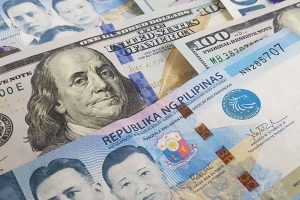THE PHILIPPINE PESO weakened slightly against the dollar on Monday as investors digested the country’s narrower balance of payment (BoP) surplus, renewed global growth concerns and persistent US-China trade tensions.
It closed at P58.17 a dollar, slipping by a centavo from P58.16 on Friday. It was the peso’s weakest finish since P58.125 on Oct. 14.
The peso opened at P58.19, strengthened to as much as P58.065 and hit an intraday low of P58.195 before settling weaker. Trading volume fell to $1.13 billion from $1.43 billion in the previous session, based on Bankers Association of the Philippines data posted on its website.
Michael L. Ricafort, chief economist at Rizal Commercial Banking Corp., said the peso softened after the release of the Philippine central bank’s BoP data showing a smaller surplus.
The BoP surplus narrowed to $82 million in September, compared with $3.5 billion a year earlier and $359 million in August. The Bangko Sentral ng Pilipinas said the slimmer surplus reflected lower foreign exchange inflows from National Government deposits and investment income overseas.
The smaller BoP surplus and weaker external buffers contributed to the peso’s mild weakness, Mr. Ricafort said, adding that global risk aversion also pushed investors toward safe-haven assets.
Concerns resurfaced over the health of US regional banks after Reuters reported rising stress across smaller lenders. Shares of Zions Bancorporation and Western Alliance rebounded on Friday after steep losses earlier in the week, easing fears of a repeat of last year’s banking turmoil.
Meanwhile, investors also weighed geopolitical risks as US President Donald J. Trump renewed threats of a 100% tariff on Chinese imports and potential export curbs on rare earth minerals, raising the risk of escalation in trade tensions.
At home, sentiment was dented by comments from Economy Secretary Arsenio M. Balisacan, who said the Philippines might only hit the lower end of its 5.5% to 6.5% growth target this year due to slower public spending tied to corruption probes and the impact of recent typhoons.
Budget Secretary Amenah F. Pangandaman maintained that the 2025 growth goal remains “attainable,” citing planned spending acceleration and improving private demand.
The peso’s direction this week may hinge on the upcoming US inflation report, delayed by the recent government shutdown. Analysts expect the Federal Reserve to cut rates by 25 basis points at its Oct. 28-29 meeting after weak job data.
In the Philippines, BSP Governor Eli M. Remolona, Jr. said further rate cuts remain possible to sustain domestic demand, following the 25-bp policy reduction earlier this month that brought the benchmark rate to 4.75%, the lowest in more than three years.
Both Mr. Ricafort and the trader expect the peso to trade from P58.05 to P58.30 a dollar on Tuesday. — Aubrey Rose A. Inosante

